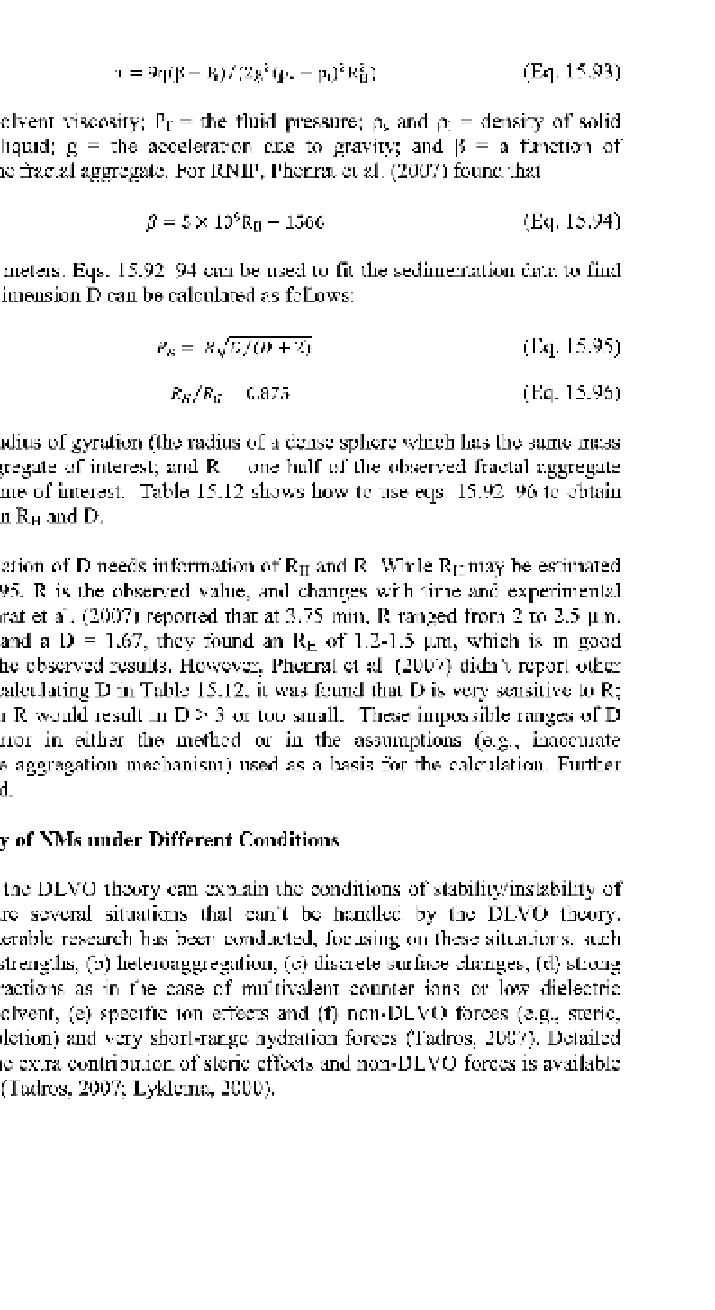Environmental Engineering Reference
In-Depth Information
T = 9ti(P - P
f
)/(2g
2
(p
s
-
Pl
)
2
R
2
H
)
(Eq. 15.93)
Where
r\ =
the solvent viscosity; Pf = the fluid pressure; p
s
and pi = density of solid
component and liquid; g = the acceleration due to gravity; and (3 = a function of
permeability of the fractal aggregate. For RNIP, Phenrat et al. (2007) found that
/5 = 5 X 10
9
R
H
- 1566
(Eq. 15.94)
with RH being in meters. Eqs. 15.92-94 can be used to fit the sedimentation data to find
RH- The fractal dimension D can be calculated as follows:
R
G
= R^D/(D +
2)
(Eq. 15.95)
R
H
/R
G
=
0.875
(Eq. 15.96)
where RG = the radius of gyration (the radius of a dense sphere which has the same mass
as the fractal aggregate of interest; and R = one half of the observed fractal aggregate
diameter at the time of interest. Table 15.12 shows how to use eqs. 15.92-96 to obtain
the information on RH and D.
The estimation of D needs information of RH and R. While RH may be estimated
with eqs. 15.92-95, R is the observed value, and changes with time and experimental
conditions. Phenrat et al. (2007) reported that at 3.75 min, R ranged from 2 to 2.5 urn.
Assuming DLA and a D = 1.67, they found an RH of 1.2-1.5 urn, which is in good
agreement with the observed results. However, Phenrat et al. (2007) didn't report other
R values. When calculating D in Table 15.12, it was found that D is very sensitive to R;
a slight change in R would result in D > 3 or too small. These impossible ranges of D
indicate some error in either the method or in the assumptions (e.g., inaccurate
assignment of the aggregation mechanism) used as a basis for the calculation. Further
research is needed.
15.5.1.5 Stability of
NMs
under Different Conditions
Although the DLVO theory can explain the conditions of stability/instability of
colloids, there are several situations that can't be handled by the DLVO theory.
Currently, considerable research has been conducted, focusing on these situations, such
as (a) high ionic strengths, (b) heteroaggregation, (c) discrete surface changes, (d) strong
electrostatic interactions as in the case of multivalent counter ions or low dielectric
constant of the solvent, (e) specific ion effects and (f) non-DLVO forces (e.g., steric,
hydrophobic, depletion) and very short-range hydration forces (Tadros, 2007). Detailed
information on the extra contribution of steric effects and non-DLVO forces is available
in the recent text (Tadros, 2007; Lyklema, 2000).

Search WWH ::

Custom Search